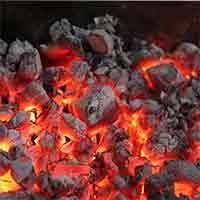
Coal rationing in and after WW2 in the UK

Coal was an essential commodity in WW2, and even though the UK produced its own coal, the war effort meant that coal was in short supply to the home market. Hence coal was rationed. It was introduced for households and businesses in January 1940 and continued until 1958, which was way after the war was over. This page explains why coal was rationed, gives dates and the amount of the coal ration and people's reactions to it.
____
By the webmaster: her early recollections with further research and contributions from others who lived at the time
The severity of coal rationing in the UK
It is difficult for anyone who was not alive at the time to understand how significant coal rationing was, as almost all domestic heating was from coal fires, hot water was from coal fired boilers or coppers and many people were still cooking on coal fired kitchen ranges. Industry, too, was powered by coal.
The amount of the coal ration
The ration was allocated by points based on needs and circumstances, such as the size of the home or business, the number of people living or working there and the nature of the work. Essential industries or services, such as hospitals or public transport, had higher allocations. Illegal black marketeering coal could lead to fines and imprisonment.
The coal ration for standard family homes was set at two and a half tons per household per year, that is just over 2500 kilos. I assume, but cannot find out for certain, that the customer could choose within the limits of availability how much of this was of a type of coal suitable for heating water in the boiler and how much for heating rooms with coal fires.
A reaction to coal rationing from a typical elderly lady
My grandmother complained bitterly about the coal ration. She had always had two hundredweight a fortnight. She needed two hundredweight (just over 100kg) a fortnight. Although she only had a fire in winter, she had always had two hundredweight of coal delivered every fortnight throughout the year for budgeting purposes. Couldn't they see - she argued - that that came to fifty-two hundredweight a year? Fifty hundredweight was no good to her. What would she do for the odd fortnight? She kept this up, and eventually 'they' relented, and she continued to have her two hundredweight a fortnight.
Richard Cole
Other reactions to coal rationing
My mother never - yes, never - had a fire during the day when she was the only person at home, when my father was at work, or later in the forces, and I was at school. She said that it wasn't necessary because she was busy doing housework or out shopping, but I can't imagine that was entirely true. It might have been to save money, but I'm sure that spinning out the coal ration had a lot to do with it.
For me, as a child, I never felt cold at school, presumably because schools were regarded as essential service providers.
---There is a whole group of detailed pages on coal purchase and delivery in the early-mid 20th Century.
If you can add anything to this page or provide a photo, I would be pleased if you would contact me.
Text and images are copyright
sources: early 20th century material
sources: ww2 home front and other material
contact
the webmaster/author/researcher/editor
privacy policy
















